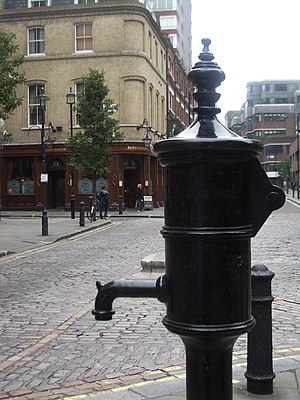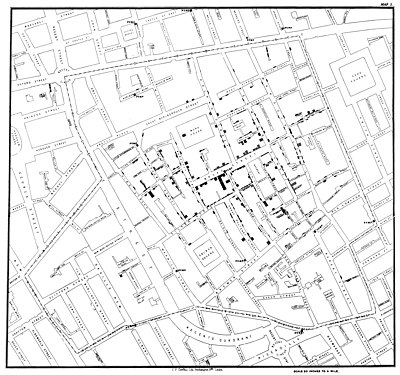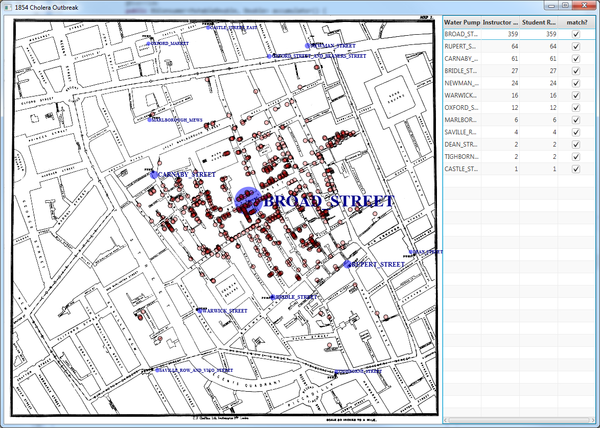Cholera MapReduce Application
Contents
Motivation
Epidemiology is the important study of "why certain people are getting ill."
We get a chance to make sense of the data in a relatively open-ended studio.
Background
Imagine you are a physician in 1854 London in the midst of a cholera outbreak. Your theory that contaminated water is the cause meets resistance from the medical establishment which holds that it is spread via the air.
Imagine further that your friend Ada has left you access to computing.
Code To Use
We have made the data from this GIS Analysis available via methods:
Code To Implement
In order to provide a more open-ended assignment, we have abstracted out different aspects of the studio. Of particular note is getValueRepresentation() which allows you to specify whether high or low numbers are suspect. That is: if you return CholeraAppValueRepresentation.HIGH_NUMBERS_SUSPECT you are indicating that a higher number is more likely to indicate that the water pump is the source of the cholera outbreak. This will aid the #Visualization in presenting your findings. We have anticipated two basic approaches to this problem (with a variation^2 on one of the approaches). If you take a different approach than one we have anticipated, that is fine. Get it checked out by an instructor.
| class: | CholeraApp.java | |
| methods: | getValueRepresentation createMapper createCollector |
|
| package: | mapreduce.apps.cholera.studio | |
| source folder: | student/src/main/java |
getValueRepresentation
method: public static CholeraAppValueRepresentation getValueRepresentation() ![]() (sequential implementation only)
(sequential implementation only)
return one of the three values to aid the visualization and testing:
public enum CholeraAppValueRepresentation {
HIGH_NUMBERS_SUSPECT, LOW_NUMBERS_SUSPECT, LOW_NUMBERS_SUSPECT_SQUARED
}
createMapper
method: public static Mapper<CholeraDeath, WaterPump, Number> createMapper() ![]() (sequential implementation only)
(sequential implementation only)
We have implemented WaterPump as an enum. You can access the enum constants of any enum via its values() method. For example:
for (WaterPump pump : WaterPump.values()) {
}
createCollector
Depending on your approach, you may be able to reuse one of your existing Collectors. Otherwise, implement one to go with your Mapper.
method: public static Collector<? extends Number, ?, ? extends Number> createCollector() ![]() (sequential implementation only)
(sequential implementation only)
Testing Your Solution
Visualization
Original Map Drawn By John Snow:
Our Visualization App:
| class: | CholeraOutbreakVisualizationApp.java | VIZ |
| package: | mapreduce.apps.cholera.viz | |
| source folder: | student/src//java |
Correctness
If you have chosen to go a different route than the ones we anticipated, do not worry about passing the test suite. Demo your work to an instructor in class and we can discuss its fitness.
| class: | CholeraStudioTestSuite.java | |
| package: | mapreduce | |
| source folder: | testing/src/test/java |


